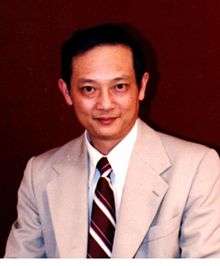Kuo-Chen Chou
Kuo-Chen Chou (周国城; born August 14, 1938) is a Chinese-American biophysicist and bioinformatician who founded and is currently affiliated with the Gordon Life Science Institute, a non-profit research organization in Boston, Massachusetts.[2] Among other contributions, he is the developer of pseudo amino acid composition (PseAAC), used in computational biology for proteomics analysis and pseudo K-tuple nucleotide composition (PseKNC) for genome analysis. He is the father of James Chou.[3]
Kuo-Chen Chou | |
|---|---|
 Kuo-Chen Chou probably in 1985 | |
| Born | August 14, 1938 |
| Nationality | American |
| Alma mater | |
| Scientific career | |
| Fields | |
| Institutions | Gordon Life Science Institute |
| Thesis | Low-Frequency Motions of Protein Molecules (1984) |
| Website | gordonlifescience |
In 2020, it was revealed that Chou had been removed from the editorial board of the Journal of Theoretical Biology and banned as a reviewer for the journal Bioinformatics for repeatedly manipulating the peer-review process to gain citations to his own papers.[4] The editors of the Journal of Theoretical Biology referred to it as "scientific misconduct of the highest order".[4]
Research
In 1972, he and his co-workers, by taking into account the spatial factor and force field factor between the enzyme and its substrate, reported that the upper limit of diffusion-controlled reaction of enzyme or diffusion limited enzyme is one order of magnitude higher than the conventional estimation, and can be used to elucidate some surprisingly high reaction rates in molecular biology.
In 1977, he predicted the existence of low-frequency phonons in proteins, followed by developing the theory of low-frequency collective motion in proteins and DNA after it had been confirmed by Raman spectroscopy.[5]
In 1995, he proposed and proved a theorem on invariance for addressing some problems often encountered in bioinformatics and cheminformatics.[6]
In 1996, he proposed the distorted key theory for guiding how to design peptide drugs.[7]
In 2011, he proposed the 5-steps rule, that has been used for proteome and genome analyses as well as predicting posttranslational modification sites in protein, RNA, and DNA sequences.[8]
As of December 2019, Chou has published over 720 scientific papers in enzyme kinetics, graphical methods in biology, protein structure prediction and function, low-frequency collective motion in macromolecules, proteome and genome analyses, and identification of posttranslational modification sites in biological sequences.[9]
Editorial roles
Chou has served multiple editorial roles, including Editor-in-Chief (2008–2019) of The Open Bioinformatics Journal, and he has been on the Editorial Board of the Journal of Theoretical Biology (2005–2019), the Journal of Biomedicine and Biotechnology (2008–2014), and The Open Biochemistry Journal (2007–2019) among others.
He is currently an Honorary Editor for The Open Bioinformatics Journal (2020–present) and Associate Editor for Medicinal Chemistry (2004–present).
Recognition
Chou's papers have been widely cited. According to Web of Science, his h-index is 135.[10] He has been continuously for five years (2014, 2015, 2016, 2017 and 2018) selected by Thomson Reuters and Clarivate Analytics as ISI Highly Cited Researcher.[11][12][13][14][15] However, it is notable that many of Chou's citations may be from manipulation of the editorial and refereeing process, per below controversy.
Editorial misconduct and citation abuse
In 2019, the journal Bioinformatics published an editorial detailing the actions of a reviewer who engaged in coercive citations.[16] In 2020, the Journal of Theoretical Biology published a further editorial claiming that the same reviewer was on their editorial board and had also engaged in coercive citation malpractice, and had engaged in further breaches of scientific conduct.[17] The journal Nature later revealed that the unnamed individual is Kuo-Chen Chou.[4]
References
- Chou, Kuo Chen; Nemethy, George; Scheraga, Harold A. (May 30, 1990). "Energetics of interactions of regular structural elements in proteins". Accounts of Chemical Research. 23 (5): 134–141. doi:10.1021/ar00173a003.
- "Gordon Life Science Institute". gordonlifescience.org.
- "Flu-drug flap". The Scientist Magazine®.
- Noorden, Richard Van (February 6, 2020). "Highly cited researcher banned from journal board for citation abuse". Nature. 578 (7794): 200–201. doi:10.1038/d41586-020-00335-7. PMID 32047304.
- Chou KC (1988). "Low-frequency collective motion in biomacromolecules and its biological functions". (secondary). Biophysical Chemistry. 30 (1): 3–48. doi:10.1016/0301-4622(88)85002-6. PMID 3046672.; Chou KC (March 1994). "Errata". Biophysical Chemistry. 49 (2): 183. doi:10.1016/0301-4622(94)85002-X.
- Chou KC (April 1995). "A novel approach to predicting protein structural classes in a (20-1)-D amino acid composition space". Proteins. 21 (4): 319–44. doi:10.1002/prot.340210406. PMID 7567954.
- Chou K.C. (1996). "Review: Prediction of human immunodeficiency virus protease cleavage sites in proteins". Analytical Biochemistry. 233 (1): 1–14. doi:10.1006/abio.1996.0001. PMID 8789141.
- Chou, Kuo-Chen (2011-03-21). "Some remarks on protein attribute prediction and pseudo amino acid composition". Journal of Theoretical Biology. 273 (1): 236–247. doi:10.1016/j.jtbi.2010.12.024. ISSN 0022-5193. PMC 7125570. PMID 21168420.
- "Kuo-Chen Chou - Google Scholar Citations". scholar.google.com.
- "Kuo-Chen Chou's Publons profile". publons.com.
- "Archived HCR Lists" (PDF).
- "Archived HCR Lists" (PDF).
- "Archived HCR Lists" (PDF).
- "Archived HCR Lists" (PDF).
- "Archived HCR Lists" (PDF).
- Wren, JD; Valencia, A; Kelso, J (15 September 2019). "Reviewer-coerced citation: case report, update on journal policy and suggestions for future prevention". Bioinformatics (Oxford, England). 35 (18): 3217–3218. doi:10.1093/bioinformatics/btz071. PMC 6748764. PMID 30698640.
- Chaplain, M; Kirschner, D; Iwasa, Y (7 March 2020). "JTB Editorial Malpractice: A Case Report". Journal of Theoretical Biology. 488: 110171. doi:10.1016/j.jtbi.2020.110171. PMID 32007131.